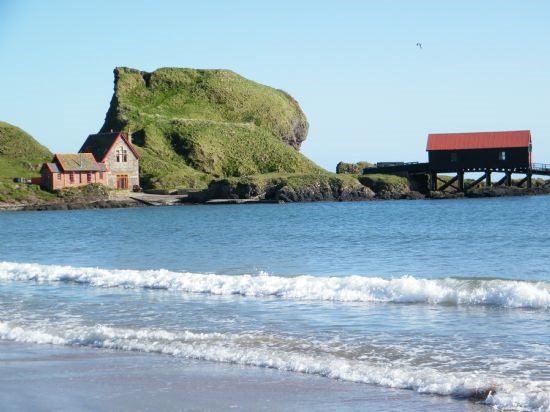Lifeboat Station
The National Lifeboat Institution's lifeboat station, built in 1869, lies at the far end of Dunavety Beach. The building has two stories. The lower one housed the lifeboat and the upper one accommodated the coxswain and his family.
The first coxswain was John Gillon, an Irish-born fisherman who was brought up in the village; but the entire crew, latterly, came down from Campbeltown in a brake to answer call-outs. The coxswain in 1906 was Henry O'Hara and the second coxswain, Charles Durnin, both Campbeltown fishermen.
Both the station itself and the first Southend lifeboat, the 25 ft-long, 10 oared John R Ker, were presented to the NLI by Mr Robert Ker, merchant, of Auchinraith in Lanarkshire, in memory of his son, who was drowned, while duck-shooting in Ronachan Bay, in north-west Kintyre. The memorial tablet is still in place in the front of the Boathouse.
The original boathouse (demolished by the elements) and slipway (derelict), closer to the Rock, were constructed in 1904 to accommodate a larger (38 ft) lifeboat, again named the John R Ker, the original slipway having been found to be useless in particular conditions.
The Wreck of the Argo
This defect was highlighted in February of 1903, when the Norwegian barque, the Argo, grounded on the Arranman's Barrels reef and the Southend lifeboat crew 'battled for hours' to launch their boat, but time and again the craft was thrown upon the beach by the great waves thundering upon the sands'. The surviving crew-members of the Argo were finally rescued by the Campbeltown lifeboat. After motor-power became established in lifeboats, thereby increasing their speed and range, such outlying stations as Dunaverty became obsolete and were closed down. In 1989, the present owner of the Boathouse donated the station's hand-operated winch and a Lister diesel engine to the Scottish Maritime Museum in Irvine.
The Outbuilding
The distinctive structure on the seaward side of the Boathouse was originally a store and boiler-room. Its renovation began in 1996 and it incorporates several interesting features.
The triangular copper window came from a lighthouse and the porthole was salvaged from a Belfast coaster, the Gracehill, which grounded on the Boiler Reef, off Sanda Island, on 8 March 1957, while on passage from Londonderry to Ayr. The Captain, James Smith, and his crew of nine, were rescued, but the 162-ft vessel could not herself be saved.
On the west side of the outbuilding, a sandstone tablet, carved by a visiting Dutch artist, Jan Lageweg, incorporates- fittingly – a symbol of compassion for all beings. The Tibetan prayer-flags, visible around the buildings, carry good wishes, which are dispersed by the winds.
